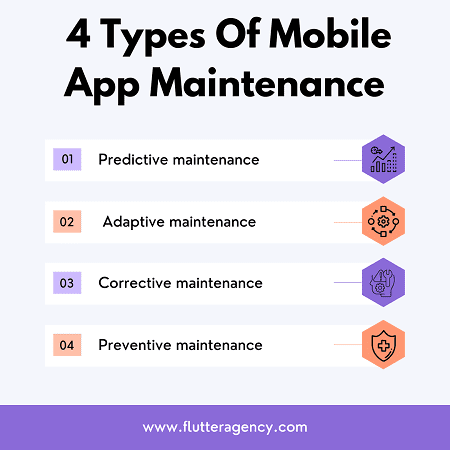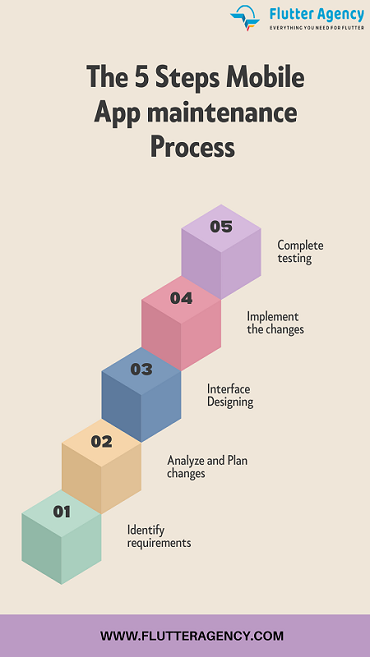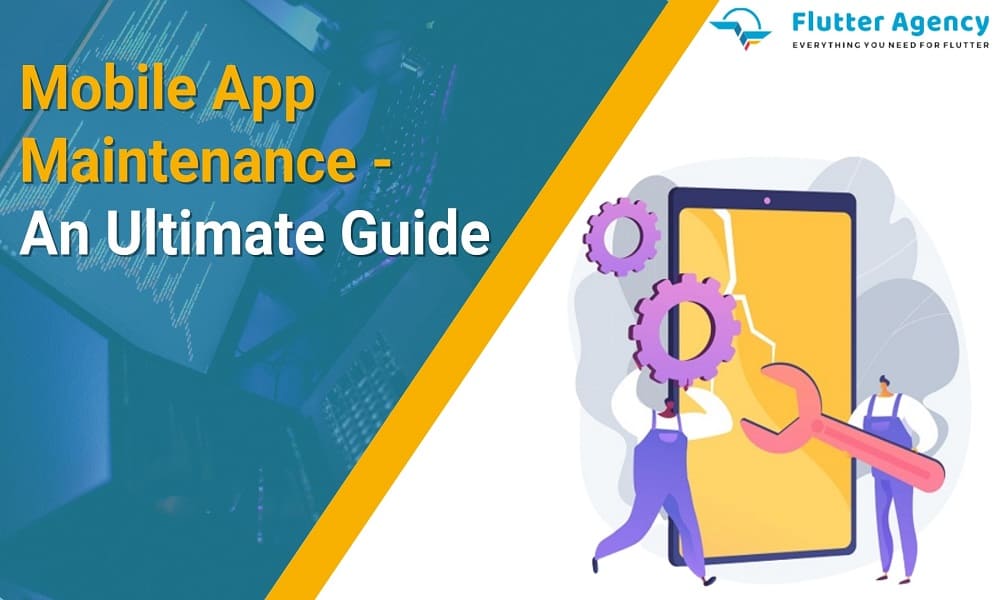Mobile App Maintenance – An Ultimate Guide
Mobile applications have changed the method for real-time and more intelligent communication. It gives the convenience of shopping from the comfort of your house to aid in accessing your financial data on the go. Hence, mobile apps have numerous benefits.
Sometimes, certain apps become obsolete as we need to be able to use them with the latest and new versions of the operating system. Thus, it is necessary to keep an eye to ensure that your applications are up to date to match the requirements of the OS.
App maintenance is vital in ensuring that your applications match the app store’s quality, design, needs and security. In this article, we will briefly discuss mobile app maintenance so that you can understand its requirement.
Introduction: Mobile App Maintenance
Mobile app maintenance is the collection of various procedures to keep the mobile app updated, error-free, active, and supportive to the users for software and hardware, monitor the performance and fix the bugs in the mobile application development process.
Some apps are built with some extra functionalities and features, so you must maintain them well, as mobile apps are out there for their constant use. Between the apps, the people who own them, and the consumers, a virtual connection must be solid and reliable to ensure a good link between them.
Reasons to Update or Maintain the Mobile App
To grow obsolete, you must update the apps to match the latest OS requirements. You have also seen that apps which need to be appropriately maintained have a low user experience.
There is also a significant drop in their performance. It affects the ratings on the app store. Hence, these apps are erased from the store after some time. Let’s see the cause of maintaining your mobile application.

1. User experience
When you invest in long-term and regular maintenance, you know what issues a user will face. It helps to monitor the user experience impacts and notice how it will affect the app engagement.
You can also see the comments and feedback that the users are giving. A maintenance schedule helps you examine how to improve usability and deliver a better experience.
When your app needs to be updated to meet the new OS version requirements, you will see friction in the app experience. It may take time to open or not allow easy clicks. Hence, it impacts the user experience, so it is necessary to maintain or update the application.
2. Quality
When you maintain the application daily, it means that you are delivering high-quality apps. Regular maintenance permits you to check for app crashes, low speed, unavailability or inaccessible user interfaces.
It will aid you in assessing if an app has errors or bugs which are required to fix immediately. You will know if the app misbehaves or is inconsistent while using the services. Apple stores are rejecting many apps because of their quality issues. If you constantly monitor and maintain the applications, you will get better-quality applications.
3. Availability
Apps become unavailable because of the bandwidth or periods for various reasons. Whenever the mobile app undergoes App maintenance and support services, you can quickly identify the reasons for its non-availability. It helps to improve the app’s design and development. Therefore, you can improve the code and increase its availability.
4. Better Design
Interruptions in the interface interactions may lead to uninstalls. You need to improve your design if you see more people facing interaction problems.
However, you will only know about design needs if you update or maintain the mobile application. With long-term maintenance, you can improve the interface design and create sync with the user’s needs.
5. Improve Security
An app which needs to be maintained or updated to meet its new needs will show security issues. You may see the vulnerabilities that are due to poor coding standards. With the help of regular maintenance, you can enhance its security, add new layers and improve its authentication. Hence, better strategies will strengthen the security dependent on the feedback, reviews and small threats.
The Types Of Mobile App Maintenance

1. Predictive maintenance
It is based on the insights which are derived from the data analysis. The analysis tool will deliver information on the incorruptibility faced by the users while they are using the application. Hence, data helps to identify the issues and give solutions. Therefore, you can proactively fix the problems and lower the maintenance frequency.
2. Adaptive maintenance
Adaptive maintenance aids you in updating the mobile application with the changing software and hardware requirements. For instance, an update in the application of a mobile operating system needs the developers to consider its adaptive maintenance.
3. Corrective maintenance
It is regular and essential maintenance. The developers can resolve existing errors and faults that enhance the application’s functionality. Therefore, it improvises the coding, designing and logic of the application.
4. Preventive maintenance
In this kind of maintenance, an app is regularly tested to check for usability, bugs and error issues. Hence, the code is optimized to meet its standards during this maintenance method.
Also, Read This Post:
A Complete Guide to Enterprise Mobile App Development Process
Way To Maintain Mobile Application
Now, let’s understand how you can maintain mobile applications.
1. Add New Features
You can identify any features the user needs whenever you monitor an app for a long while. But, also notice the elements which have a lower engagement of the users. Identifying must-have features and ones you remove helps you maintain the app better.
However, during app maintenance, you must go through reviews shared by the users. At the same time, you should also look at notes shared during app user monitoring. Hence, it will aid you in implementing the app’s features.
2. Supports Hardware/Software Support
Both Android and iOS have received their version updates. However, the apps released before a version update should be usable on the new OS versions launched recently.
Thus, it is necessary to assess the compatibility with its new hardware and software versions to enhance usability.
Hence, if you do not like the work on the latest and new versions, you may need to update the application for the new upgrades.
3. Update the Interface
The design styles, guidelines, and mobile app consumption is constantly evolving. Your application needs to meet the new needs of users and platforms. Hence, you must ensure an interface is updated for further usage protocol and interface guidelines.
When you see that a user is spending more time on the mobile application, then you will be able to notice them better. Thus, it helps you to plan interface updates and ensure that your UI is on the level of the latest mobile app trends.
4. Fix bugs
Monitoring the application regularly to go through its issues and bugs is essential. When you fix the bugs on time, you can see that a user is satisfied and engaged and spends more time in your app.
If the bugs are not solved, there will be issues in the performance and leading to the application crash. Hence, as part of your maintenance routine, you should instantly check and fix the bugs.
5. Monitor Performance
Loading time is essential when you use an application. You may see user attrition if an app takes a long time to open. As a part of the maintenance routine, you should monitor an application’s performance. Hence notice the speed, friction in usage and loading time for the application.
6. Check for licenses
When developing the application, you must use licensed technology. However, every license comes with a renewal date. You should check whether any rights of the application have been renewed. As a result, you can avoid the high renewal costs and ensure timely license updates.
5 Steps Process For The Maintenance Of Your Mobile Application
Let’s see some steps that help you ensure timely and predictive maintenance for fewer maintenance cycles and updated mobile applications.

1. Identify Requirements
You must identify any necessary changes when planning the maintenance cycle of your mobile app. It helps you to club an activity into the maintenance type. For instance, it will be the corrective maintenance if you plan to fix the bugs.
It could be part of regular maintenance if you wish to add features or enhanced functionality. Hence, you can identify maintenance types and determine methods per the requirements and demands.
2. Analyze and Plan Changes
Once you have set the list of the modifications to be done during the maintenance, it’s time to check its feasibility. Every detail should be thoroughly examined and analyzed for feasibility and expertise.
Once you have implemented the practical changes in your app, you must discuss it with the team to plan these maintenance-related activities. If you have planned it properly, you can accomplish it on time.
3. Designing for New Features or Interface changes
This step is correct if you plan to implement the new features or changes. It would be best if you underwent the design stage of the interface or the visual changes you plan to implement.
You can only integrate these changes by knowing how an interface or design should look. You must implement this step to build the architectural and structural changes.
4. Implement the Changes
Once you have created essential changes, you must implement them in the pre-production stage. It is necessary to commit these changes correctly. However, you have made sure that you have identified the specifications and will accordingly implement the changes.
5. Complete Testing
Once you have determined and finished the changes, you should commit the build for testing. QA engineers should assess the modifications to check if it meets the quality standards and usability.
Hence, the team will determine if any code and interface need the desired maintenance goals. For example, if you want to improve an app’s functionality, the testing engineer should check if it does.
Also, Read This Post:
5 Essential Tips For Developing A Secure Mobile App?
Security Strategies for Maintenance
While maintaining the mobile application, you should take care of some points. It is necessary to incorporate your application’s security demands when planning maintenance.
1. Install Necessary SSL Certificates
Whether you are developing or upgrading the existing application, checking the SSL certificates is necessary. You should view if the licenses have run out. However, if you keep this updated, you will ensure that an app’s server is aligned with the security needs of your application.
2. Encrypt devices for better security
Hackers and malware threaten the data stored in the mobile app. That’s why it is essential to save the data within the devices using encryption. Hence, users should not be able to transfer data from one device to another without permission. If you do not give this security in your application, it is also called a vulnerability.
Conclusion
Mobile app maintenance helps you enhance the application’s quality and performance. It makes sure that your app is usable and experience is frictionless. It will erase the bugs and solve the problems that frustrate users.
However, you require the proper plan and partner to fix the issues and repair those bugs. Flutter Agency delivers maintenance and support services to mobile app owners. We provide a separate package of mobile app maintenance besides development. If you wish to know your system’s mobile app maintenance needs and how to proceed, then consult our team. We will deliver customized packages and exceptional solutions to help you meet your mobile app maintenance goals.
Frequently Asked Questions (FAQs)
1. What is included in mobile app maintenance?
A standard mobile app maintenance plan includes bug fixing, performance monitoring, security updates and compatibility updates when the new Android and iOS version is released in the market.
2. How often does an app require maintenance?
A successful app is updated at least once a month, which includes bug fixing and new feature releases. The frequency of your app update will be based on several feature requests and bug reports from users and also from the resources of your software maintenance team.
3. What is the cost of app maintenance?
The average cost of maintaining the app is about 15-20% of its initial development cost per year, only if you have fixed the bugs and other standard activities. However, to retain the users, you must put in more effort.
Contemporary ventures
Recent blog
ready to get started?
Fill out the form below and we will be in touch soon!
"*" indicates required fields













